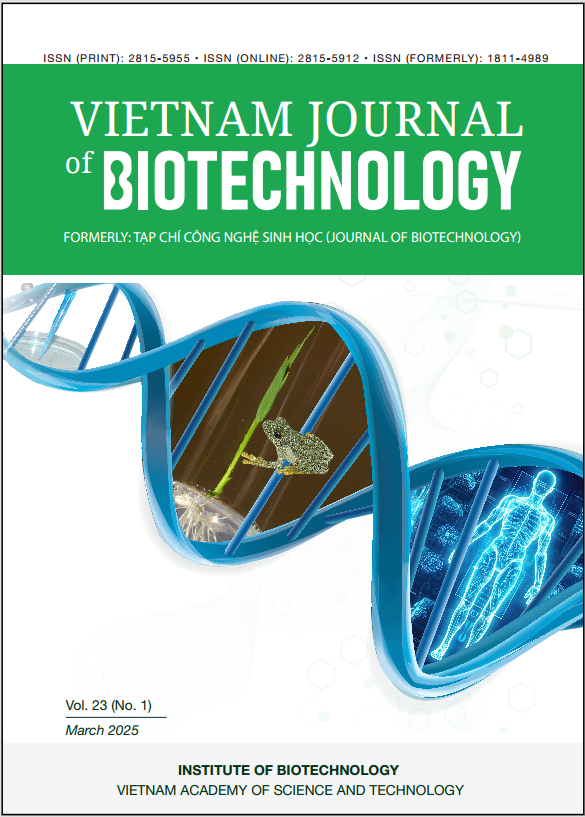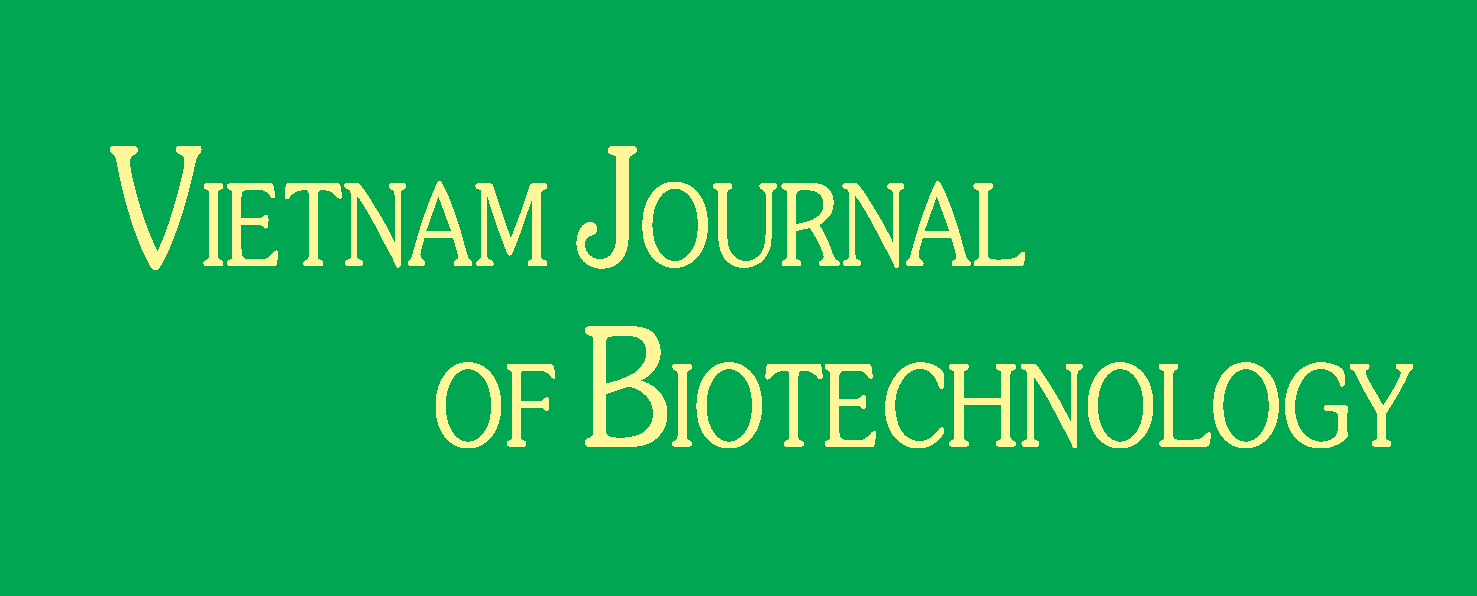Assessment of genetic stability and photoreceptor gene expression (CmPHYA and CmPHYB ) of Chrysanthemum indicium plantlets culture on medium containing molybdenum trioxide nanoparticles
Author affiliations
DOI:
https://doi.org/10.15625/vjbt-22200Keywords:
Chrysanthemum indicum, in vitro culture, gene expression, genetic stability, molybdenum trioxide nanoparticlesAbstract
This study investigated the effects of molybdenum trioxide nanoparticles (MoO₃NPs) on the rooting, genetic stability, photosynthesis-related gene expression, and nursery-stage growth of Chrysanthemum indicum. The rooting stage analysis revealed that the 6.4 µg/L MoO₃NPs treatment significantly enhanced rooting rate, plantlet height, leaf number, root number, root length, SPAD value, and fresh weight compared to control treatments. ITS sequence analysis confirmed that MoO₃NPs did not induce mutations or genetic instability, with the ITS sequences of treated plantlets showing 100% similarity with those in the NCBI database and control samples. MoO₃NPs supplementation also upregulated the expression of CmPHYA and CmPHYB, critical genes encoding photoreceptors involved in red and far-red light perception, enhancing photosynthetic efficiency. At the nursery stage, plantlets derived from MoO₃NPs-supplemented media demonstrated superior growth parameters, including plant height, leaf and root numbers, fresh and dry weight, and SPAD value. These findings underscore the potential of MoO₃NPs to improve plantlet development, photosynthetic performance, and nutrient absorption, thereby highlighting their role in sustainable plant production systems.
Downloads
References
Aboul-Maaty, N. A. F. and Oraby, H. A. S. (2019). Extraction of high-quality genomic DNA from different plant orders applying a modified CTAB-based method. Bulletin of the National Research Centre, 43(1), 1-10. https://doi.org/10.1186/s42269-019-0066-1
Adeniran, A. A., Sonibare, M. A., Rajacharya, G. H. and Kumar, S. (2018). Assessment of genetic fidelity of Dioscorea bulbifera L. and Dioscorea hirtiflora Benth. and medicinal bioactivity produced from the induced tuberous roots. Plant Cell, Tissue and Organ Culture, 132, 343-357. https://doi.org/10.1007/s11240-017-1334-0
Anna, B., Barbara, K. and Magdalena, O. (2018). How the surface properties affect the nanocytotoxicity of silver? Study of the influence of three types of nanosilver on two wheat varieties. Acta Physiologiae Plantarum, 40, 1-7. https://doi.org/10.1007/s11738-018-2613-z
Arnon, D. I. and Stout, P. R. (1939). Molybdenum as an essential element for higher plants. Plant Physiology, 14(3), 599. https://doi.org/10.1104/pp.14.3.599
Bekheet, S. A., Gabr, A. M. M., Reda, A. A. and El Bahr, M. K. (2015). Micropropagation and assessment of genetic stability of In Vitro raised jojoba (Simmondsia chinensis Link.) plants using SCoT and ISSR markers. Plant Tissue Culture and Biotechnology, 25(2), 165-179.
Casal, J. J., Candia, A. N. and Sellaro, R. (2014). Light perception and signalling by phytochrome A. Journal of Experimental Botany, 65(11), 2835-2845. https://doi.org/10.1093/jxb/ert379
Chen, S., Yao, H., Han, J., Liu, C., Song, J., Shi, L., et al. (2010). Validation of the ITS2 region as a novel DNA barcode for identifying medicinal plant species. PloS One, 5(1), e8613. https://doi.org/10.1371/journal.pone.0008613
Duncan D. B. (1955). Multiple range and multiple F tests. Biometrics. 11(1), 1-42.
Gao, L., Shi, C., Yang, Z., Jing, W., Han, M., Zhang, J., et al. (2023). Convection-enhanced delivery of nanoencapsulated gene locoregionally yielding ErbB2/Her2-specific CAR-macrophages for brainstem glioma immunotherapy. Journal of Nanobiotechnology, 21(1): 56. https://doi.org/10.1186/s12951-023-01810-9
Ghosh, M., Ghosh, I., Godderis, L., Hoet, P., and Mukherjee, A. (2019). Genotoxicity of engineered nanoparticles in higher plants. Mutation Research/Genetic Toxicology and Environmental Mutagenesis, 842, 132-145. https://doi.org/10.1016/j.mrgentox.20-19.01.002
Gopinath, K., Gowri, S., Karthika, V. and Arumugam, A. (2014). Green synthesis of gold nanoparticles from fruit extract of Terminalia arjuna, for the enhanced seed germination activity of Gloriosa superba. Journal of Nanostructure in Chemistry, 4, 1-11. https://doi.org/10.1007/s40097-014-0115-0
Jogam, P., Sandhya, D., Shekhawat, M. S., Alok, A., Manokari, M., Abbagani, S. et al. (2020). Genetic stability analysis using DNA barcoding and molecular markers and foliar micro-morphological analysis of in vitro regenerated and in vivo grown plants of Artemisia vulgaris L. Industrial Crops and Products, 151: 112476. https://doi.org/10.1016/j.indcrop.2020.112476
Kim, M., Osone, S., Kim, T., Higashi, H. and Seto, T. (2017). Synthesis of nanoparticles by laser ablation: A review. KONA Powder and Particle Journal, 34, 80-90. https://doi.org/10.14356/kona.2017009
Kumari, M., Khan, S. S., Pakrashi, S., Mukherjee, A. and Chandrasekaran, N. (2011). Cytogenetic and genotoxic effects of zinc oxide nanoparticles on root cells of Allium cepa. Journal of Hazardous Materials, 190(1-3), 613-621. https://doi.org/10.1016/j.jhazmat.2011.03.095
Legris, M., Klose, C., Burgie, E. S., Rojas, C. C. R., Neme, M., Hiltbrunner, A., et al. (2016). Phytochrome B integrates light and temperature signals in Arabidopsis. Science, 354(6314), 897-900. https://doi.org/10.1126/science.aaf5656
Li, D. Z., Gao, L. M., Li, H. T., Wang, H., Ge, X. J., Chen, Z. D., et al. (2011). Comparative analysis of a large dataset indicates that internal transcribed spacer (ITS) should be incorporated into the core barcode for seed plants. Proceedings of the National Academy of Sciences, 108(49), 19641-19646. https://doi.org/10.1073/pnas.1104551108
Li, J., Wan, Q., Guo, Y. P., Abbott, R. J. and Rao, G. Y. (2014). Should I stay or should I go: biogeographic and evolutionary history of a polyploid complex (Chrysanthemum indicum complex) in response to Pleistocene climate change in China. New Phytologist, 201(3), 1031-1044. https://doi.org/10.1111/nph.12585
Li, Y., Liu, C., Shi, Q., Yang, F. and Wei, M. (2021). Mixed red and blue light promotes ripening and improves quality of tomato fruit by influencing melatonin content. Environmental and Experimental Botany, 185: 104407. https://doi.org/10.1016/j.envexpbot.2021.104407
Mai, N. T., Binh, P. T., Khoi, P. H., Hung, N. K., Ngoc, P. B., Ha, C. H., et al. (2016). Effects of light emitting diodes-led on regeneration ability of Coffea canephora mediated via somatic embryogenesis. Academia Journal of Biology, 38(2), 228-235.
Mehrian, S. K. and De Lima, R. (2016). Nanoparticles cyto and genotoxicity in plants: mechanisms and abnormalities. Environmental Nanotechnology, Monitoring and Management, 6, 184-193. https://doi.org/10.1016/j.enmm.2016.08.003
Mendel, R. R. and Leimkühler, S. (2015). The biosynthesis of the molybdenum cofactors. JBIC Journal of Biological Inorganic Chemistry, 20, 337-347. https://doi.org/10.1007/s00775-014-1173-y
Muellner, A. N., Schaefer, H. and Lahaye, R. (2011). Evaluation of candidate DNA barcoding loci for economically important timber species of the mahogany family (Meliaceae). Molecular Ecology Resources, 11(3), 450-460. https://doi.org/10.1111/j.1755-0998.2011.02984.x
Murashige, T. and Skoog, F. (1962). A revised medium for rapid growth and bio assays with tobacco tissue cultures. Physiologia Plantarum, 15(3): 143. https://doi.org/10.1111/j.1399-3054.1962.tb08052.x
Narula, A., Kumar, S. and Srivastava, P. S. (2007). Genetic fidelity of in vitro regenerants, encapsulation of shoot tips and high diosgenin content in Dioscorea bulbifera L., a potential alternative source of diosgenin. Biotechnology Letters, 29, 623-629. https://doi.org/10.1007/s10529-006-9276-3
Nguyen, P. L. H., Thuy, N. T. T., Mai, N. T. N., Hoa, H. C. K., Khai, H. D., Tung, H. T., et al. (2024). The role of MoO3NPs on regeneration, growth and development of chrysanthemum cultured in vitro. Plant Cell Tissue and Organ Culture, 158(1), 4. https://doi.org/10.1007/s11240-024-02806-5
Patlolla, A. K., Berry, A., May, L. and Tchounwou, P. B. (2012). Genotoxicity of silver nanoparticles in Vicia faba: a pilot study on the environmental monitoring of nanoparticles. International Journal of Environmental Research and Public Health, 9(5), 1649-1662. https://doi.org/10.3390/ijerph9051649
Rana, M. S., Bhantana, P., Imran, M., Saleem, M. H., Moussa, M. G., Khan, Z., et al. (2020). Molybdenum potential vital role in plants metabolism for optimizing the growth and development. Annals of Environmental Science and Toxicology, 4(1), 32-44. https://dx.doi.org/10.17352/aest.000024
Roso, R., Nunes, U. R., Müller, C. A., Paranhos, J. T., Lopes, S. J., Dornelles, S. H. B., et al. (2020). Light quality and dormancy overcoming in seed germination of Echium plantagineum L. (Boraginaceae). Brazilian Journal of Biology, 81(3), 650-656. https://doi.org/10.1590/1519-6984.228777
Roy, S., Tyagi, A., Shukla, V., Kumar, A., Singh, U. M., Chaudhary, L. B., et al. (2010). Universal plant DNA barcode loci may not work in complex groups: a case study with Indian Berberis species. Plos one, 5(10): e13674. https://doi.org/10.1371/journal.pone.0013674
Shang, W., Song, Y., Zhang, C., Shi, L., Shen, Y., Li, X., Wang, Z. and He, S. (2023). Effects of light quality on growth, photosynthetic characteristics, and endogenous hormones in in vitro-cultured Lilium plantlets. Horticulture, Environment, and Biotechnology, 64(1), 65-81. https://doi.org/10.1007/s13580-022-00468-w
Shao, Y., Sun, Y., Li, D. and Chen, Y. (2020). Chrysanthemum indicum L.: A comprehensive review of its botany, phytochemistry and pharmacology. The American Journal of Chinese Medicine, 48(04), 871-897. https://doi.org/10.1142/S0192415X20500421
Siddiqui, M. H., Al-Whaibi, M. H., Firoz, M. and Al-Khaishany, M. Y. (2015). Role of nanoparticles in plants. Nanotechnology and plant sciences: nanoparticles and their impact on plants. Nanotechnology and Plant Sciences, 19-35.
Singh, H. K., Parveen, I., Raghuvanshi, S. and Babbar, S. B. (2012). The loci recommended as universal barcodes for plants on the basis of floristic studies may not work with congeneric species as exemplified by DNA barcoding of Dendrobium species. BMC Research Notes, 5, 1-11. https://doi.org/10.1186/1756-0500-5-42
Tymoszuk, A. and Miler, N. (2019). Silver and gold nanoparticles impact on in vitro adventitious organogenesis in chrysanthemum, Gerbera and Cape Primrose. Scientia Horticulturae, 257: 108766. https://doi.org/10.1016/j.scienta.2019.108766
Wang, L., Kong, W., Yang, M., Han, J. and Chen, S. (2015). Safety issues and new rapid detection methods in traditional Chinese medicinal materials. Acta Pharmaceutica Sinica B, 5(1), 38-46. https://doi.org/10.1016/j.apsb.2014.12.005
Wang, S., Meng, X., Tang, Z., Wu, Y., Xiao, X., Zhang, G., et al. (2022). Red and blue LED light supplementation in the morning pre-activates the photosynthetic system of tomato (Solanum lycopersicum L.) leaves and promotes plant growth. Agronomy, 12(4): 897. https://doi.org/10.3390/agronomy12040897
White, T. J. (1990) Amplification and direct sequencing of fungal ribosomal RNA genes for phylogenetics. In: PCR protocols, a guide to methods and applications. Academic Press, New York, USA.
Wu, M. H., Li, L., Liu, N., Wang, D. J., Xue, Y. C. and Tang, L. (2018). Molybdenum disulfide (MoS2) as a co-catalyst for photocatalytic degradation of organic contaminants: a review. Process Safety and Environmental Protection, 118, 40-58. https://doi.org/10.1016/j.psep.2018.06.025
Yao, H., Song, J., Liu, C., Luo, K., Han, J., Li, Y., et al. (2010). Use of ITS2 region as the universal DNA barcode for plants and animals. PloS One, 5(10): e13102. https://doi.org/10.1371/journal.pone.0013102
Zhang, M., Hu, C., Zhao, X., Tan, Q., Sun, X., Cao, A., Cui, M. and Zhang Y. (2012). Molybdenum improves antioxidant and osmotic-adjustment ability against salt stress in Chinese cabbage (Brassica campestris L. ssp. Pekinensis). Plant and Soil, 355, 375-383. https://doi.org/10.1007/s11104-011-1109-z
Zhang, M., Hu, C., Zhao, X., Tan, Q., Sun, X., Cao, A., et al. (2012). Molybdenum improves antioxidant and osmotic-adjustment ability against salt stress in Chinese cabbage (Brassica campestris L. ssp. Pekinensis). Plant and Soil, 355, 375-383. https://doi.org/10.1007/s11104-011-1109-z
Zheng, L., Su, M., Yang, F., Zhou, J. and Zhang, Q. (2020). Nano-molybdenum trioxide facilitates photosynthesis and antioxidant defense system in soybean (Glycine max L.). Plant Physiology and Biochemistry, 146, 124-133. https://doi.org/10.1016/j.plaphy.2019.11.012
Downloads
Published
How to Cite
Issue
Section
Funding data
-
Vietnam Academy of Science and Technology
Grant numbers NCXS01.03/22-24







